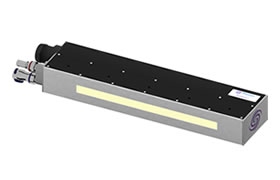The global flexible packaging market continues to evolve as shifts in consumer preference lean more toward convenience in single-serve or grab-n-go options, extended shelf life and sustainability. In addition to consumers driving innovation in flexible packaging, wide web and narrow web converters are beginning to converge into the packaging space as they see increased opportunity in equipment and coating technologies, thereby lowering the barrier to entry. With the advancements in ultraviolet light emitting diodes (UV LED) curing technology, opportunities in the flexible packaging space become more available to the converter base.
Flexographic packaging market trends
According to a Smithers Pira forecast, the global flexographic printing industry was expected to reach $980 billion last year, primarily driven by growth in packaging and labels. With more than 15,000 label converters and almost 500 flexible packaging converters globally – operating multiple press technologies in multiple plants – there is growing merger and acquisition activity that is converging the two market segments, convoluting the packaging space while strengthening a converter’s position. With the label market slated to grow only 2% annually and flexible packaging at a strong 5%, there is even more reason for a company to acquire adjacent technologies or competitors to complement its business strategy.
Many drivers are attributed to the growth in the flexographic packaging market, including consumer preferences (particularly from millennials, who desire convenience and single-serve packaging), the need for increased shelf life, pet food manufacturers moving away from multiwall bags to flexible packaging and growing interest in moving away from rigid to flexible structures.
Flexographic market segments
The flexographic market segments can be divided into three primary categories: narrow web, mid web and wide web, each defined in Table 1. Note: the widths defining each market segment are a general specification and not stated industry standard.

Due to the significant growth in flexographic flexible packaging, the limitations of traditional UV curing technologies that currently prohibit label and flexible packaging converters from participating in this segment have been exposed. This is particularly true in the food and beverage segment, which is more than 50% of the overall flexible packaging market. One way to eliminate the barrier is to fully understand the benefits of UV LED technology and the value it brings to the flexible packaging market.
Types of UV LED flexographic formulations and technologies
Inks, coatings and adhesives formulated for cure with UV LED are increasingly gaining traction in the narrow, mid and wide web markets. While some formulations – such as silicone-release and highly functional coatings – with smaller overall market demand have seen limited UV LED development, the broader portfolio of UV LED-formulated inks, coatings and adhesives already exist commercially for a wide range of converter requirements. In situations when off-the-shelf formulations are not the best match for a particular application, the existing formulation typically can be modified to fit the converter’s specific processing, construction or application needs.
The greatest commercial use today at press speeds of up to 1,000 fpm are UV LED formulated line, process and high-density inks, in both general purpose and low-migration formulations. Metallic and fluorescent UV LED variations also are being adopted by converters, since the use of UV LED curing sources results in a truer and brighter cured metallic and fluorescent look. In addition, fluorescents have been shown to fade less when passed under multiple UV LED lamps on a press than with a similar number of passes under conventional mercury lamps. Recent formulation improvements in clear UV LED primers, laminating adhesives and protective over-varnishes now are enabling nonyellowing in the final cure at increasing press speeds that are approaching those of UV LED cured inks.
Advantages of UV LED curing
While new narrow web presses sometimes are sold with hot air driers for water-based and solvent-based formulations, the majority are equipped with UV driers. This is due to the many operational and final product advantages that UV curing offers converters and brand owners.
For the mid and wide web flexo, gravure and coating market segments, presses are generally built to run water-based, solvent-based or solventless inks, coatings and adhesives. Converters often will run a UV-cured silicone release coating in nitrogen, a UV-cured protective over-varnish or a laminating adhesive in combination with these formulations. This is commonly done offline or at a specified distance from the solvent formulations in order to comply with appropriate explosion-proofing requirements. It is important to note that, due to the electrical design of UV LED sources and their compactness, UV LED curing offers the potential to convert many of these mid and wide web applications to UV and even run UV LED technology inline with solvent formulations.
Regardless of the web width or press configuration, UV LED curing offers all the advantages associated with conventional mercury lamps, as well as additional environmental, operational and performance benefits.
Tags: UV+EB Technology Magazine | UV LED Curing for Flexographic Printing Applications | AshlandCategories: Inks | Printing, Flexo
